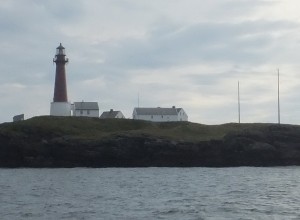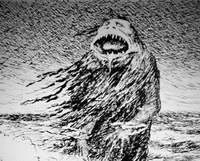Four metre waves batter our ferry on the fiercest piece of water in the world. We’re 100km west of the Norwegian mainland and this is the Maelstrom, first mentioned by the Greeks 3000 years ago and immortalised in the iconic writings of Edgar Allen Poe and Jules Verne.
But it’s the artist and poet Theodor Severin Kittelsen who’s the icon here, his sketches of trolls and wildlife legendary; and I wonder what could drive a man said to be lyrical, macabre, anthropomorphic, soulful and poetic. Only one day earlier a Lofoten blacksmith suggested “personal demons”.
“You’ve heard of him?” Marius seemed surprised. “With not so much printed in the English language, I am thinking he does not receive the international attention.” Marius is thinking out loud, peering intently at a newly formed cormorant glowing red between smithy’s calipers. “This man, he could capture the mind and the moods… the conditions of Norwegian society and nature.”
I’m reminded of a sketch lying flat in the grey pressed-metal cabinet of an Oslo museum: an ancient crone with bent back shuffling from house to house. This is Kittelsen’s The Black Death. She journeys a winding fjordside path, by cliff and rock; a black, hooded cloak hiding all but those wide eyes, cold and grey. In one hand she carries an upright rake that some may escape, but her broom will catch all.
Kittelsen is born in southern Norway, 1857; 11yo when his father dies, leaving him to work as an errand-boy.
His artistic gift recognised at 17, he studies in Oslo and later Munich, helped by a generous benefactor. That support ends in 1879, Kittelsen leaving to eke out a living as a draughtsman for German magazines and newspapers. In 1882 he’s granted a Paris scholarship, but seems lost and longing for the simple life. “It is becoming clearer, and clearer to me what I have to do,” he writes, “and I have had more ideas – but I must, I must get home.” He returns to Norway in 1887.
The following two years find Kittelsen in Lofoten, with his sister and brother-in-law south of here at Skomvær Lighthouse. He discovers nature, his greatest comfort, adding text to his emotive collection of drawings.
Our ferry rolls as we pass the coastal ghost town of Hell – somewhere outside – Autumnal clouds heavy with rain,billowing seas grey, buckets of white crash against a ferry window barely a metre from my girlfriend’s shoulder. The bow rises and drops. There’s a shuddering thump and I worry how the cars below will cope, consoling myself with the Norwegians being old hands on perilous seas.
Our ferry pushes on towards the smaller island of Værøy, surely a concoction of a Norwegian Dr Moreau. Gigantic, jagged peaks sprout from smudged ocean gloom, their sides almost vertical, piercing clouds, melded leaden sky.
From Sørland wharf, we drive north to a group of buildings dwarfed by the towering 450m Nordlandsnupen backdrop; this place the original hub of Værøy, the one-time Lutheran vicarage, now a glorious guesthouse.
“Kittelsen?” Hege asks with raised eyebrows. “Yah, but of course. He was here!” She points to the building opposite our own refurbished-chicken-house lodgings, and hunts down a bulky volume from cluttered shelves of books and an odd mix of island birds; some taxidermist’s discarded pride and joy.
Hege returns with the blue bound, gold-embossed gem, Fra Lofoten, Kittelsen’s signature bold and sweeping. “A confident man?” asks Hege, “I am not so sure.” She nods her head and again raises her eyebrows. “He was an artist, after all.”
That night the wind howls and rattles windows: the same wind Kittelsen knew when sketching and writing here, confiding in the Lutheran priest and compiling Fra Lofoten; leading the acclaimed Norwegian artist Christian Krohg to surmise, “Lofoten is what suddenly has made Kittelsen into the poet and great artist that he is… his vision is universal, unpretentious and explicit.”
In the morning I linger outside Kittelsen’s room next door to ours, soaking up Arctic sun in the lee of those charcoal-shadowed cliffs. Værøy crows whirr, and croaks rise from secret stone ledges; others catching cold updrafts to disappear from view.
The next day we’re on the island of Røstlandlet – ‘Røst’ to locals – the pitter-patter of soft rain on an open awning window. At breakfast the morning outside is grey and as flat as Røst, ‘flat as a pancake’ on tourist brochures, with 640 human inhabitants surrounded by 300 islets and 2.5 million nesting birds on season.
Finn has lived here all his life, takes tourists out to the bird islands, in what was once the island doctor’s boat. He peers up at a featureless sky. “Mmmm, maybe not today,” he says as he sniffs the air, “it will be better.” Intended to put our minds at ease, Finn tells the story of the local church destroyed in an 1835 hurricane; the spire and attached bells blown clear off and dumped on the ground. He’ll take us tomorrow, weather permitting, to Kittelsen’s Skomvær.
In the morning we pass the triple-peaked Trenyken, Finn pondering Kittelsen’s trolls; and an Italian archaeologist finding a cave with 3000-year-old cave paintings: mysterious red-ochre figures, giant trolls with odd-shaped heads.
Finally there’sSkomvær Island, the last stop till Iceland; not as flat as Røst, the 1887 lighthouse sitting on low green pastures, behind us the sculptured stacks of Kittelsen’s bird islands.
Returning to the mainland in 1889, Kittelsen marries; a self-portrait has him bearded, head turned slightly, pale eyes pensive with an intense inner glow that follows me around the room. The brow is slightly furrowed, the hair short and brownish-fair under an artist’s deep hessian skullcap; the dark, crumpled, jacket open to reveal a linen shirt and collar.
Life was difficult for Kittelsen, his wife and nine children. As time passed the artist’s health failed, the family forced to sell the home and leave for Oslo in 1910.
Kittelsen died at age 57, his friend Christian Skredsvig lamenting “…there will never be anyone to succeed him. Even the trolls have disappeared for always. At any rate, I have never seen them since.”
The mainland ferry approaches, the Arctic wind loaded with the smell of salt and wooden racks of salted cod. I dally by the terminal, peering through jetty cracks to the heaving black below, before gazing out to sea. Three silent cormorants sit on a nearby skerry, wet wings extended out to dry, long snakelike necks and hooked beaks held high. These must surely be THE three cormorants of Røst, an ancient tale of bird brothers in a magical land south of Skomvær, and sketched by Kittelsen; a land where drowned sailors live forever, visiting their families in the form of cormorants.
The horizon is blurred, bird islands laden with ethereal swirls. Sheer granite slabs fall to a wine dark sea. Weird rocky knolls are giant trolls, all warts and wild whiskers. Mysterious hunched figures brood in tumbled cloaks, hiding spell books and pondering the ways of timeless oceans. Ragged mountain crags are cyclopean shapes, heads with crooked faces and big noses. Clouded silhouettes are sirens, the wind their toxin song – Kittelsen’s visions as mystical as anything Homer imagined.

Island Solace – Skomvaer Lighthouse, Lofoten, Norway
*** Opening feature image of `The Sea Troll’ by artist Theodor Severin Kittelsen ***


Informative. Thanks. No photos or pictures of Kittelsen? I found a few grainy photos and self-portraits. People have said -of one photo of him (sideview), in his early ’50’s- that I am a doppelgänger. Any suggestions/links you can help with?
Thank you,
Paul Luoma
Thanks Paul,
Have seen some good pictures of the man.
Interesting I guess, if you do share a resemblance. He was a remarkable talent.
Great post Ian. What a terrific story. Just been watching a series about Scandinavia, it reminded me of the time I spent in Denmark when I was young, wonderful country, I’d love to go back sometime.
Thanks Dale,
A wonderfully wild & watery corner of the world.
Ian, I really appreciate being introduced to the work of Theodor Kittelsen. I was not aware of this talented Norwegian artist. Quite a tribute to him by his friend, Christian Skredsivg, “…there will never be anyone to succeed him. Even the trolls have disappeared for always.” Difficult life though and I wonder if he was driven by personal demons. Enjoyed your descriptions and photos as you traveled through that part of Norway. Loved Kittelsen’s sketches, such depth and imagination! Yes, “visions as mystical as anything Homer imagined.” Wonderful post!
You are always so kind JL. But yes… quite an artist.
Not an artist I’d ever heard of before. Looking at what you’e posted and what you wrote, his stuff is very much a reflection of his surroundings.
Liked the bit about the dead sailors returning as cormorants too.
Yes indeed BigD, can’t imagine those scenes being anywhere else in the world… except maybe the northern Scottish Isles.
Ian, your words do Kittlesen honor. Your bring the stark, forbidding landscape he poeticized so well in his drawings back to life.
I’m duly flattered NP.
Thank you.
I’ve never heard of Kittelsen. Thanks for introducing him to me. The black and white of his sketches really capture the starkness of the area. Looks like you had an interesting journey, yourself. Cool!
Hullo Janene.
Although Kittelsen did use colour, I agree the black & white creations to be more moving.
As a kid, I remember having an illustrated Scandinavian storybook that had all sorts of trolls, goblins, and fairies in it. I wonder if maybe some of those illustrations were by Kittelsen? Norway and Iceland seem like such magical places, and your piece captured that imagery so nicely.
The fact that you recall those sketches Kris, indicates a real impact on you as a kid. I’m thinking they must have been by Kittelsen.
Ian, few writers make me live the moments the way your words can. That was an amazing world of white and grey, freezing sea, craggy hills among the omnipresent snow, mingled with the story of Kittelsen. You have capture the indescribable without a flinch.
`a world of white & grey’. Yes Uma, there is definitely something about those places… craggy, wild & windswept.